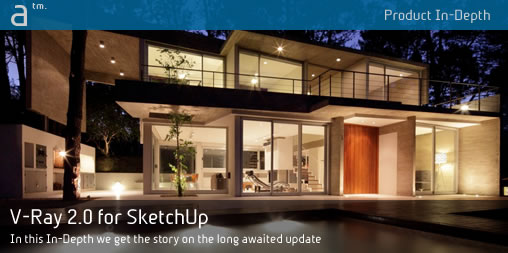Several months ago the Chaos Group, the developer of the popular V-Ray rendering engine, contacted us to talk to us about an upcoming product for SketchUp. That product, V-Ray 2.0 for SketchUp was initially going to be called version 1.6. But the update was so substantial and important that a full digit release was decided instead.
Beginnings
For those who are not quite familiar with the Chaos Group, the Bulgarian software firm sprung to the scene back in 1997 and have been a growing and powerful force in rendering realism ever since. From its beginnings as a two person outfit to today with a staff of over 100 spread across offices in the US, Europe, Japan and Korea, the Chaos Group is at the bleeding edge of still, interactive and animation rendering technologies.
V-Ray itself celebrated its 10th anniversary in 2012 and for 2013 the group has promised to revolutionize rendering precision and speed in the upcoming version 3.0.
Growing and Expanding
In our discussion Lon Grohs, vice president of business development, Chaos Group, said, “Today the Chaos Group is a growing entity…and the V-Ray brand and technology is being leveraged and utilized by more and more artists across the industry’s best 3D software suites.”
V-Ray has been a popular choice among leading 3D software packages. Today the rendering engine is a software plugin option for Autodesk 3ds Max, Autodesk Maya, Autodesk Softimage, as well as V-Ray for Rhino and V-Ray for SketchUp. In addition to V-Ray Chaos Group also sells Pdplayer, created by Asynthetic and distributed by Chaos Group, the product is an image sequencer that supports multiple layers for color correction and compositing of animation sequences. It works with QuickTime in its latest version and works on Mac OS X as well as Windows and Linux.
The company also makes a fluid simulator (fluid dynamics) named Phoenix FD for Autodesk 3ds Max. However, it is V-Ray that is the company’s chief asset as Lon Grohs futher explains the decision to put much more emphasis into SketchUp.
“We have 250 resellers worldwide–we are growing and its really exciting. But we further anticipate this new product for SketchUp to really add momentum.”
The V-Ray Argument
If you sit down with a group of 3D artists they will argue tooth and nail over why they use their tools of choice and why they feel they are the best. Yet, out of this cloud of debate a rare group of tools garner enough shared respect that even if someone chooses not to use that tool they will have much respect and interest in hearing others talk about it. V-Ray is one of those technologies.

01 – V-Ray 2.0 for SketchUp includes a new Dome Light for dramatically simplified setup of image-based lighting (IBL). This is one of three major features we discuss in detail in this article. (image courtesy of the Chaos Group. All rights reserved.)
Although the company says V-Ray is used in games and film–including “Iron Man”–Architosh readers who have heard of it will likely associate it with very high-end and ultra-realistic architectural renderings. (see image 01 above and the title graphic above–which isn’t a real photo if you can believe it?)
“We have a strong focus and pursuit on speed,” said Lon Grohs. “The core technologies we have allow artists to visualize their designs quickly and with great accuracy…and we keep pushing the boundaries of that with every version.” The company said because of their fanatical attention to detail and realism artists in pursuit of these goals gravitate to V-Ray.
Indeed, some of the imagery coming off of V-Ray engine-powered applications is truly stunning. But with V-Ray 2.0 for SketchUp the company is taking a unique approach relative to that application’s particular strengths.
next page: Speed, Simplicity and Power





Reader Comments
Peeradon Warithkorasuth liked this on Facebook.
Peeradon Warithkorasuth liked this on Facebook.
Thomas Bank liked this on Facebook.
Thomas Bank liked this on Facebook.
[…] 2.0 for SketchUp 2.0 was featured here on Architosh for those who want to learn about accessing this […]
Comments are closed.